You are using an out of date browser. It may not display this or other websites correctly.
You should upgrade or use an alternative browser.
You should upgrade or use an alternative browser.
Export thread
LA150 Oil Sump & Other Adventures
#1
G
Gumby83
G
Gumby83
I’m taking some time this winter to repair the oil sump leak on my mean-green-grass-cuttin-machine as well as repair or maybe improve some other things while I’m at it. I thought it’d be nice to have a dedicated thread to share pics and ask advice as needed along the way.
Here’s the beast in all its original radiance and glory - sans deck, of course. Since I have limited garage space, the deck was better off stored in the shed and out of the way.
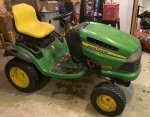
The primary goals are:
1) Oil sump leak - resealing entire engine while I’m at it.
2) Steering & linkage - gears are nearly stripped and the right tie rod is loose.
3) Front axle spindles - Replacing with all new components if possible. I need to verify it, but a quick glance while replacing the bushings this past spring made it look as though the right spindle was bent.
If time allows, I’d also like to:
(Edit) -Add temp gauge just because I like being able to monitor it.
-Make a custom set of less-than-impressive hub caps.
-Figure out how to reinforce or further stabilize the wheel bearings.
-Thoroughly clean tractor and touch up paint.
-Repair tear in seat.
-Service transmission.
-Repair/replace miscellaneous wiring that has cracked insulation.
I’ll update once or twice a week depending on progress. I’m only putting a few hours a week into this as there’s always more irons in the fire than this blacksmith can keep up with.
Here’s the beast in all its original radiance and glory - sans deck, of course. Since I have limited garage space, the deck was better off stored in the shed and out of the way.

The primary goals are:
1) Oil sump leak - resealing entire engine while I’m at it.
2) Steering & linkage - gears are nearly stripped and the right tie rod is loose.
3) Front axle spindles - Replacing with all new components if possible. I need to verify it, but a quick glance while replacing the bushings this past spring made it look as though the right spindle was bent.
If time allows, I’d also like to:
(Edit) -Add temp gauge just because I like being able to monitor it.
-Make a custom set of less-than-impressive hub caps.
-Figure out how to reinforce or further stabilize the wheel bearings.
-Thoroughly clean tractor and touch up paint.
-Repair tear in seat.
-Service transmission.
-Repair/replace miscellaneous wiring that has cracked insulation.
I’ll update once or twice a week depending on progress. I’m only putting a few hours a week into this as there’s always more irons in the fire than this blacksmith can keep up with.
#3
G
Gumby83
Thanks for the link - I’m sure you were just trying to help - but I can’t stop laughing about it. It reminds me of “Let me google that for you” (which, on some level of irony, I had to google because I haven’t looked at it in years). http://letmegooglethat.com/?q=PARTS+JD+LA150


 ?
?
G
Gumby83
Thanks for the link - I’m sure you were just trying to help - but I can’t stop laughing about it. It reminds me of “Let me google that for you” (which, on some level of irony, I had to google because I haven’t looked at it in years). http://letmegooglethat.com/?q=PARTS+JD+LA150
#4
G
Gumby83
G
Gumby83
So here’s a picture of the nasty mess I want to correct. It looked this way when I got it, so I washed it off as clean as possible with a pressure washer and took a closer look at the source the next time I ran it.
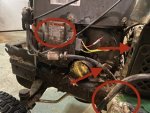
I couldn’t see exactly where it’s coming from due to the shields, but using the google and looking at parts diagrams helped me determine it’s likely the sump gasket. And even if that’s not what it turns out to be, this is an oil leak I don’t want to deal with for another season. Every time I parked it after mowing, it reeked of burning oil - I was just waiting for a spontaneous fire.
And what is that white powdery substance, marked by red circles and arrows (undoubtedly inserted by someone with extensive photo editing experience ? ), you ask? That’s the contents of an ABC fire extinguisher courtesy of a rectifier that had a bad attitude about its job...
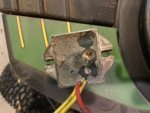
I tried for about 2 minutes to smother the flame but it was inside the regulator and blatantly refused to be extinguished by any other method. Jerk.
So far I’ve just started taking the shroud and external components off - I mostly just wanted to share those pics as I found them quite entertaining.

I couldn’t see exactly where it’s coming from due to the shields, but using the google and looking at parts diagrams helped me determine it’s likely the sump gasket. And even if that’s not what it turns out to be, this is an oil leak I don’t want to deal with for another season. Every time I parked it after mowing, it reeked of burning oil - I was just waiting for a spontaneous fire.
And what is that white powdery substance, marked by red circles and arrows (undoubtedly inserted by someone with extensive photo editing experience ? ), you ask? That’s the contents of an ABC fire extinguisher courtesy of a rectifier that had a bad attitude about its job...

I tried for about 2 minutes to smother the flame but it was inside the regulator and blatantly refused to be extinguished by any other method. Jerk.
So far I’ve just started taking the shroud and external components off - I mostly just wanted to share those pics as I found them quite entertaining.
#5
M
mechanic mark




M
mechanic mark
Thanks for pictures, looks like you have your work cut out for you, good luck. I apply fresh grease to steering sector & pinion gears every service after wiping off old grease from gears. Pictures of my 2010 Simplicity Broadmoor steering & sector gears.So here’s a picture of the nasty mess I want to correct. It looked this way when I got it, so I washed it off as clean as possible with a pressure washer and took a closer look at the source the next time I ran it.
View attachment 55211
I couldn’t see exactly where it’s coming from due to the shields, but using the google and looking at parts diagrams helped me determine it’s likely the sump gasket. And even if that’s not what it turns out to be, this is an oil leak I don’t want to deal with for another season. Every time I parked it after mowing, it reeked of burning oil - I was just waiting for a spontaneous fire.
And what is that white powdery substance, marked by red circles and arrows (undoubtedly inserted by someone with extensive photo editing experience ? ), you ask? That’s the contents of an ABC fire extinguisher courtesy of a rectifier that had a bad attitude about its job...
View attachment 55210
I tried for about 2 minutes to smother the flame but it was inside the regulator and blatantly refused to be extinguished by any other method. Jerk.
So far I’ve just started taking the shroud and external components off - I mostly just wanted to share those pics as I found them quite entertaining.
Attachments
#6
G
Gumby83
Yeah I doubt any kind of lubricant has been intentionally applied to these gears. The sector gear isn’t in too bad of shape but the column gear definitely needs replacement.
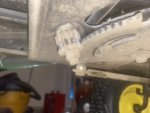
In an effort to tighten the steering just for this past season, I removed the column gear and attempted to drill out the flange on it so I could invert the gear on the column. But that didn’t work out, so I just put it back on, knowing I’d be tackling it this winter.
G
Gumby83
Thanks for pictures, looks like you have your work cut out for you, good luck. I apply fresh grease to steering sector & pinion gears every service after wiping off old grease from gears. Pictures of my 2010 Simplicity Broadmoor steering & sector gears.
Yeah I doubt any kind of lubricant has been intentionally applied to these gears. The sector gear isn’t in too bad of shape but the column gear definitely needs replacement.

In an effort to tighten the steering just for this past season, I removed the column gear and attempted to drill out the flange on it so I could invert the gear on the column. But that didn’t work out, so I just put it back on, knowing I’d be tackling it this winter.
#7
G
Gumby83
G
Gumby83
And there it is - the source of the leak. I got the carburetor/intake and throttle linkage removed last night and found this near the #1 cylinder.
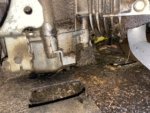
For those that don’t know - you can almost always identify the source of leak (especially one this bad) by looking for the area that appears clean, relative to its surroundings. As oil leaks out, it “washes” away the grime and filth that collects. This is true for any system that utilizes oil of any type, be it engine, transmission, hydraulics, or other applications.

For those that don’t know - you can almost always identify the source of leak (especially one this bad) by looking for the area that appears clean, relative to its surroundings. As oil leaks out, it “washes” away the grime and filth that collects. This is true for any system that utilizes oil of any type, be it engine, transmission, hydraulics, or other applications.
#8
G
Gumby83
G
Gumby83
So I got the engine removed from the mower and the case split tonight. The internals look pretty good - no signs of excessive contamination or damage to the bearing or gear surfaces.
Once the case was split, it was pretty easy to see why the gasket failed - I don’t know if this engine has been apart before, but it would appear that during assembly, the gasket was misaligned, or perhaps the case bolts were over torqued.
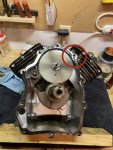
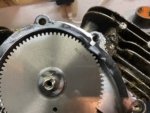
Also, while moving the engine around, I noticed the sound of something rattling around and thought “So begins the real fun.” It turned out to be a screen for the oil pump - looks like it can be pressed or tapped back into place, but I think I’ll apply some sleeve retainer to it to make sure it stays in place.
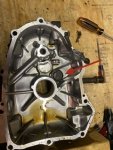
I’m yet to remove the valves from the heads for inspection/cleaning, but other than normal carbon build up, everything looks good.
Also, I used some scrap aluminum and 2x4 to build a makeshift stand for the engine. I stripped it down as far as I could on the mower, but wanted it on the bench for removing the heads and splitting the case. I didn’t tie the 2x4 together, so I was able to split the halves apart while leaving them on.
Also, if you’re like me and you struggle with organizing, The second picture is an easy way to keep track of bolts/screws. Most of them will punch through the cardboard easily enough, but for some of the larger bolts, you can cut a slit using a knife or punch through with a screwdriver first. The advantage to using an old box is it will accommodate several different lengths and, for the most part, will keep a good enough grip on the bolts that they won’t scatter everywhere if the box is dropped or accidentally kicked. It can also be rotated to utilize more than one side at a time.
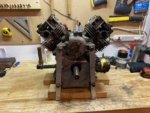
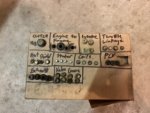
Once the case was split, it was pretty easy to see why the gasket failed - I don’t know if this engine has been apart before, but it would appear that during assembly, the gasket was misaligned, or perhaps the case bolts were over torqued.


Also, while moving the engine around, I noticed the sound of something rattling around and thought “So begins the real fun.” It turned out to be a screen for the oil pump - looks like it can be pressed or tapped back into place, but I think I’ll apply some sleeve retainer to it to make sure it stays in place.

I’m yet to remove the valves from the heads for inspection/cleaning, but other than normal carbon build up, everything looks good.
Also, I used some scrap aluminum and 2x4 to build a makeshift stand for the engine. I stripped it down as far as I could on the mower, but wanted it on the bench for removing the heads and splitting the case. I didn’t tie the 2x4 together, so I was able to split the halves apart while leaving them on.
Also, if you’re like me and you struggle with organizing, The second picture is an easy way to keep track of bolts/screws. Most of them will punch through the cardboard easily enough, but for some of the larger bolts, you can cut a slit using a knife or punch through with a screwdriver first. The advantage to using an old box is it will accommodate several different lengths and, for the most part, will keep a good enough grip on the bolts that they won’t scatter everywhere if the box is dropped or accidentally kicked. It can also be rotated to utilize more than one side at a time.


#9
G
Gumby83
G
Gumby83
I’m still working on tear down, but I would like to take the case halves, heads and shields to work and use the hot tank to clean them. I prefer to have them completely stripped down when using the hot tank, so I’ve got a couple questions:
1) How can the governor & gear be removed? I don’t see a nut on the case exterior to suggest it’s anchored that way (and I would hope not, considering it butts up against the cylinder wall). If I open the jaws I can see what looks like a circlip on the shaft, just above the gear, which leads me to believe it should “pop” off of there, but for obvious reasons, I don’t want to try prying it.
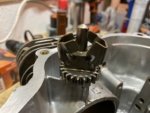
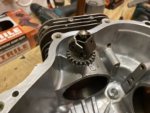
2) Is the oil pressure relief valve a pain to replace? It looks like the only way to get the plug out is by using a chisel to pry it out - again, not ideal, but I’d like to have the case stripped down for cleaning. I haven’t yet checked on part availability yet either.
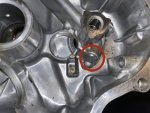
1) How can the governor & gear be removed? I don’t see a nut on the case exterior to suggest it’s anchored that way (and I would hope not, considering it butts up against the cylinder wall). If I open the jaws I can see what looks like a circlip on the shaft, just above the gear, which leads me to believe it should “pop” off of there, but for obvious reasons, I don’t want to try prying it.


2) Is the oil pressure relief valve a pain to replace? It looks like the only way to get the plug out is by using a chisel to pry it out - again, not ideal, but I’d like to have the case stripped down for cleaning. I haven’t yet checked on part availability yet either.

#10
G
Gumby83
G
Gumby83
So I decided to give up on trying to remove the governor gear and oil pressure relief valve and got the case halves and heads into work to clean in the hot tank. I just made sure to blast them with compressed air and then give them a shot of penetrating oil afterwards.
I was surprised to learn there was an engine under all that filth! ?
I’m going to reassemble the case tonight, then finish cleaning the carbon off the heads and valves tomorrow.
I haven’t yet gotten into the carburetor or the steering/front axle work, but the engine work is going somewhat fast so I’ll probably be there by next week.
Here’s a pic of the chassis. I decided to strip it down this far so I could get it thoroughly cleaned. I’m going to load it on my trailer and take it to the car wash for that. Also a good time to replace the entire fuel line.
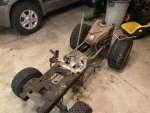
I was surprised to learn there was an engine under all that filth! ?
I’m going to reassemble the case tonight, then finish cleaning the carbon off the heads and valves tomorrow.
I haven’t yet gotten into the carburetor or the steering/front axle work, but the engine work is going somewhat fast so I’ll probably be there by next week.
Here’s a pic of the chassis. I decided to strip it down this far so I could get it thoroughly cleaned. I’m going to load it on my trailer and take it to the car wash for that. Also a good time to replace the entire fuel line.

#12
G
Gumby83



I was considering it. I’m confident a 4 banger would bolt on nicely with a few custom brackets. And by “custom” I mean a few pieces of angle iron and an arc welder. ?
Reminds me of an episode of “Home Improvement” where Tim Allen mounted a turbine engine on a lawnmower to beat Bob Vila in a race.
G
Gumby83
time to build a hot rod....
I was considering it. I’m confident a 4 banger would bolt on nicely with a few custom brackets. And by “custom” I mean a few pieces of angle iron and an arc welder. ?
Reminds me of an episode of “Home Improvement” where Tim Allen mounted a turbine engine on a lawnmower to beat Bob Vila in a race.
#14
G
Gumby83
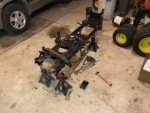
Ok, somebody’s not trying hard enough to stop me from telling myself “while it’s apart I might as well do that too....”
Once I got it cleaned up, I just couldn’t help myself but pull the front axle and transmission. It was just too easy - I’d of had to remove the front axle pivot bolt nut anyway because the anchor plate for the deck’s front adjuster is cracked. I don’t think it’ll take much to repair.
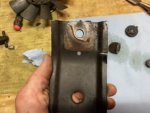
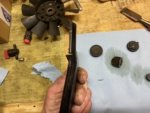
Except for polishing the front axle bushing surfaces, I’ve got everything cleaned up and ready for assembly, as well as all my replacement parts.
Which reminds me - with the front axle being cast iron, there’s not many options for improvement on the wear surfaces for the spindles without getting too complicated - but I was wondering if anyone has tried using a thrust bearing between the axle and spindle? If so, how did it work out? I don’t expect to eliminate the need for grease by any stretch, but it seems reasonable to think it would reduce the amount of turning effort.
I’ll post some pics for clarity next chance I get.
G
Gumby83

Ok, somebody’s not trying hard enough to stop me from telling myself “while it’s apart I might as well do that too....”
Once I got it cleaned up, I just couldn’t help myself but pull the front axle and transmission. It was just too easy - I’d of had to remove the front axle pivot bolt nut anyway because the anchor plate for the deck’s front adjuster is cracked. I don’t think it’ll take much to repair.


Except for polishing the front axle bushing surfaces, I’ve got everything cleaned up and ready for assembly, as well as all my replacement parts.
Which reminds me - with the front axle being cast iron, there’s not many options for improvement on the wear surfaces for the spindles without getting too complicated - but I was wondering if anyone has tried using a thrust bearing between the axle and spindle? If so, how did it work out? I don’t expect to eliminate the need for grease by any stretch, but it seems reasonable to think it would reduce the amount of turning effort.
I’ll post some pics for clarity next chance I get.
#15
G
Gumby83
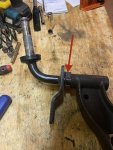
The arrow notes the position I’m considering using a thrust bearing. JD just used a washer - looks/feels like steel but maybe it’s softer and intended to be the wear point.
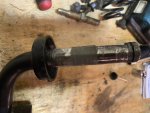
And, bent or not, I’m replacing the spindles. This is the right side which was the worst of the 2. The left side had a little wear but nothing even close to this.
G
Gumby83

The arrow notes the position I’m considering using a thrust bearing. JD just used a washer - looks/feels like steel but maybe it’s softer and intended to be the wear point.

And, bent or not, I’m replacing the spindles. This is the right side which was the worst of the 2. The left side had a little wear but nothing even close to this.
#17
G
Gumby83
Nope, not even a little. My experience with anti-seize compounds in automotive have taught me to only trust it in very specific situations.
Most anti-seize is just grease that has some type of powdered lubricant mixed in with it. For contact areas that don’t need consistent lubrication - threads, mating surfaces between steering knuckles and wheel hubs, or axle shafts and wheel hubs, for example - this is OK; but for contact areas that slide against each other - such as the surfaces on these spindles, or meshing gears - the powdered lubricant can act more like an abrasive and wear them out faster.
In areas of higher temperatures, what little moisture is present in the grease can be dried out, creating even more drag. I’ve seen this countless times when customers think they’re doing good for their cars by applying anti-seize to their wheel lugs - depending on how long the wheels have been on there, the lug nuts are much more difficult to remove. Then I have to spend extra time cleaning/chasing the threads to ensure the lugs are evenly torqued, and a simple service like tire rotation turns into an hour long endeavor when it should only take 10 minutes.
Of course there’s several factors to consider, and I’m not saying there’s no good uses for anti-seize, but I’m very picky about when I use it for anything.
G
Gumby83
Antiseize Compound.
Nope, not even a little. My experience with anti-seize compounds in automotive have taught me to only trust it in very specific situations.
Most anti-seize is just grease that has some type of powdered lubricant mixed in with it. For contact areas that don’t need consistent lubrication - threads, mating surfaces between steering knuckles and wheel hubs, or axle shafts and wheel hubs, for example - this is OK; but for contact areas that slide against each other - such as the surfaces on these spindles, or meshing gears - the powdered lubricant can act more like an abrasive and wear them out faster.
In areas of higher temperatures, what little moisture is present in the grease can be dried out, creating even more drag. I’ve seen this countless times when customers think they’re doing good for their cars by applying anti-seize to their wheel lugs - depending on how long the wheels have been on there, the lug nuts are much more difficult to remove. Then I have to spend extra time cleaning/chasing the threads to ensure the lugs are evenly torqued, and a simple service like tire rotation turns into an hour long endeavor when it should only take 10 minutes.
Of course there’s several factors to consider, and I’m not saying there’s no good uses for anti-seize, but I’m very picky about when I use it for anything.
#18
X
xray man
X
xray man
View attachment 55450
Ok, somebody’s not trying hard enough to stop me from telling myself “while it’s apart I might as well do that too....”
Once I got it cleaned up, I just couldn’t help myself but pull the front axle and transmission. It was just too easy - I’d of had to remove the front axle pivot bolt nut anyway because the anchor plate for the deck’s front adjuster is cracked. I don’t think it’ll take much to repair.
View attachment 55451
View attachment 55452
Except for polishing the front axle bushing surfaces, I’ve got everything cleaned up and ready for assembly, as well as all my replacement parts.
Which reminds me - with the front axle being cast iron, there’s not many options for improvement on the wear surfaces for the spindles without getting too complicated - but I was wondering if anyone has tried using a thrust bearing between the axle and spindle? If so, how did it work out? I don’t expect to eliminate the need for grease by any stretch, but it seems reasonable to think it would reduce the amount of turning effort.
I’ll post some pics for clarity next chance I get.
Dadgumit... you're making me wanna tear my LT120 down. If I didn't still need it to pull my Cyclone leaf sucker upper I'd be tempted to do it. For now I'll watch you have all the fun.So I decided to give up on trying to remove the governor gear and oil pressure relief valve and got the case halves and heads into work to clean in the hot tank. I just made sure to blast them with compressed air and then give them a shot of penetrating oil afterwards.
I was surprised to learn there was an engine under all that filth! ?
I’m going to reassemble the case tonight, then finish cleaning the carbon off the heads and valves tomorrow.
I haven’t yet gotten into the carburetor or the steering/front axle work, but the engine work is going somewhat fast so I’ll probably be there by next week.
Here’s a pic of the chassis. I decided to strip it down this far so I could get it thoroughly cleaned. I’m going to load it on my trailer and take it to the car wash for that. Also a good time to replace the entire fuel line.
View attachment 55285
#19
M
mechanic mark
M
mechanic mark
Educate yourself son:https://www.google.com/search?q=ANT...ome..69i57.36038j0j4&sourceid=chrome&ie=UTF-8Nope, not even a little. My experience with anti-seize compounds in automotive have taught me to only trust it in very specific situations.
Most anti-seize is just grease that has some type of powdered lubricant mixed in with it. For contact areas that don’t need consistent lubrication - threads, mating surfaces between steering knuckles and wheel hubs, or axle shafts and wheel hubs, for example - this is OK; but for contact areas that slide against each other - such as the surfaces on these spindles, or meshing gears - the powdered lubricant can act more like an abrasive and wear them out faster.
In areas of higher temperatures, what little moisture is present in the grease can be dried out, creating even more drag. I’ve seen this countless times when customers think they’re doing good for their cars by applying anti-seize to their wheel lugs - depending on how long the wheels have been on there, the lug nuts are much more difficult to remove. Then I have to spend extra time cleaning/chasing the threads to ensure the lugs are evenly torqued, and a simple service like tire rotation turns into an hour long endeavor when it should only take 10 minutes.
Of course there’s several factors to consider, and I’m not saying there’s no good uses for anti-seize, but I’m very picky about when I use it for anything.
#20
G
Gumby83
G
Gumby83
Between bitterly cold temps and other life events, I had to put this on hold for a few weeks. But now the snow disappeared overnight and I better get back to reassembly.
Everything’s going together nicely. I didn’t have time to paint the rust spots but there’s always next winter. The engine is ready to be mounted back on the frame and I’ve got all the wiring run except for the temp gauge I want to add. I gathered a few scraps of 4 gauge from work and made all new cables for the battery, solenoid and starter.
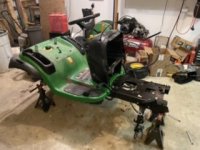
The steering and front axle are all back together and installed - unfortunately the steering gear (column only, not sector) in the kit I bought was too small for the column diameter, so I have a replacement coming from the local JD supplier.
I also got the anchor plate for the mower front adjustment bent back in shape and welded.
Once I get the engine mounted and the shields installed, all that’s left is the carburetor.
Everything’s going together nicely. I didn’t have time to paint the rust spots but there’s always next winter. The engine is ready to be mounted back on the frame and I’ve got all the wiring run except for the temp gauge I want to add. I gathered a few scraps of 4 gauge from work and made all new cables for the battery, solenoid and starter.

The steering and front axle are all back together and installed - unfortunately the steering gear (column only, not sector) in the kit I bought was too small for the column diameter, so I have a replacement coming from the local JD supplier.
I also got the anchor plate for the mower front adjustment bent back in shape and welded.
Once I get the engine mounted and the shields installed, all that’s left is the carburetor.
#21
B
Born2Mow
B
Born2Mow
Believe me, you won't be the first guy with $15,000 wrapped up in a motorized item with a Blue Book value of $200 !! ?Ok, somebody’s not trying hard enough to stop me from telling myself “while it’s apart I might as well do that too....”
#22
G
Gumby83

G
Gumby83
Most of that will be spent adding a sweet stereo system.Believe me, you won't be the first guy with $15,000 wrapped up in a motorized item with a Blue Book value of $200 !! ?
#23

Hammermechanicman
Hammermechanicman
Famous words heard at every car dealership
"For just a few dollars we can get you into a ........."
"For just a few dollars we can get you into a ........."
#24
G
Gumby83
G
Gumby83
Meant to share these as well. The first 2 are the adjuster bracket post-repair but pre-rattle can. All I did was bend the bracket back to its original shape, then used a cutting wheel to open up the seam (cutting a little deeper than the original crack) and MIG welded it.
The next was a spur of the moment decision to mount the fuel line shut off in the frame - I’m glad it worked out because I took a SWAG (scientific wild a** guess) at the location - it was pretty close to not being a good one.
I wanted it closer to the tank just so it wouldn’t interfere with the linkages closer to the engine. I used a 3/4” hole saw and mounted it with padded clamps and 1/4” bolts. I’d searched for a metal petcock type valve but didn’t find one that I was confident would work in this location so I settled for the plastic one I already had and may replace it with a metal one in the future.
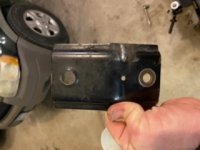
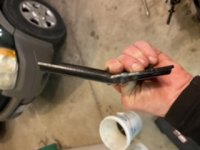
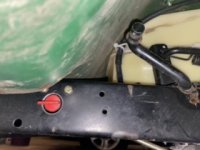
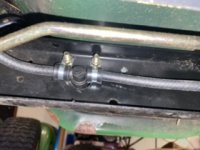
The next was a spur of the moment decision to mount the fuel line shut off in the frame - I’m glad it worked out because I took a SWAG (scientific wild a** guess) at the location - it was pretty close to not being a good one.
I wanted it closer to the tank just so it wouldn’t interfere with the linkages closer to the engine. I used a 3/4” hole saw and mounted it with padded clamps and 1/4” bolts. I’d searched for a metal petcock type valve but didn’t find one that I was confident would work in this location so I settled for the plastic one I already had and may replace it with a metal one in the future.




#25
G
Gumby83
G
Gumby83
So when I went to install the flywheel, I realized I didn’t have a good way of holding it for torquing. I’d already installed the drive and clutch pulleys so I didn’t want to rely on the bolt for those. I settled on a 2.5” bolt and my 24” pipe wrench - it worked pretty well. The wrench grips the bolt and the socket I had was just a little bit smaller than the flange, so I was able to torque it without interference. Just thought that was a good tip to share.
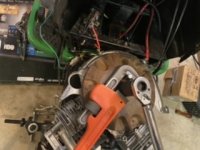
I’d been wanting to add a better drain valve for the oil, but wasn’t able to find anything I was satisfied with, so for now I settled on a 4” galvanized fitting and elbow with plug to at least keep the oil from draining/dripping onto the frame.
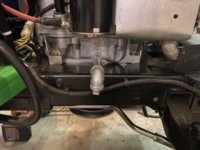
And finally, I started on the temp gauge install. I debated with myself for quite a while about whether or not to purchase ready made CHT kit, but it just seemed overpriced for what it was - plus I’d have to buy 2 of them because I couldn’t find anyone offering a kit with 2 probes.
I was finding thermocouples for cheap and the only visible difference between a thermocouple or a CHT thermocouple was the ring lug.
I realized the ring lug on the CHT sensor was basically just a large electrical eyelet with a thermocouple secured to it, so I took a shot at making my own. I couldn’t find any ring lugs large enough to fit around the base of the spark plugs, so I decided to try placing the probes on the bottom heat shield bolt on either head. It’s not be the most accurate place for the measurement, but again, I’m just looking for a baseline temp to use as a reference, so we’ll see how it goes.
I don’t have the gauge/reader installed yet but I readied the probes.
I’m using 2 type K thermocouples wired in parallel. I found a 5 pack on Amazon for about $15 - the plugs on them happen to be the exact same spacing as the terminals on the reader, so I’m gonna drill holes in them to accommodate the screws so I don’t have to try and secure 2 single strands of wire to them.
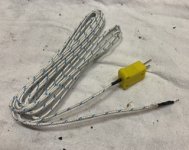
All I did to make the probe was insert the thermocouple into the eyelet without crimping it, then used the heat shrink to secure it. The eyelet is sandwiched between the head and heat shield with the bolt run through it
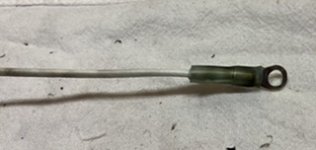
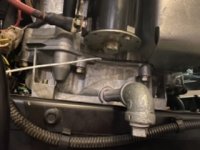

I’d been wanting to add a better drain valve for the oil, but wasn’t able to find anything I was satisfied with, so for now I settled on a 4” galvanized fitting and elbow with plug to at least keep the oil from draining/dripping onto the frame.

And finally, I started on the temp gauge install. I debated with myself for quite a while about whether or not to purchase ready made CHT kit, but it just seemed overpriced for what it was - plus I’d have to buy 2 of them because I couldn’t find anyone offering a kit with 2 probes.
I was finding thermocouples for cheap and the only visible difference between a thermocouple or a CHT thermocouple was the ring lug.
I realized the ring lug on the CHT sensor was basically just a large electrical eyelet with a thermocouple secured to it, so I took a shot at making my own. I couldn’t find any ring lugs large enough to fit around the base of the spark plugs, so I decided to try placing the probes on the bottom heat shield bolt on either head. It’s not be the most accurate place for the measurement, but again, I’m just looking for a baseline temp to use as a reference, so we’ll see how it goes.
I don’t have the gauge/reader installed yet but I readied the probes.
I’m using 2 type K thermocouples wired in parallel. I found a 5 pack on Amazon for about $15 - the plugs on them happen to be the exact same spacing as the terminals on the reader, so I’m gonna drill holes in them to accommodate the screws so I don’t have to try and secure 2 single strands of wire to them.

All I did to make the probe was insert the thermocouple into the eyelet without crimping it, then used the heat shrink to secure it. The eyelet is sandwiched between the head and heat shield with the bolt run through it


